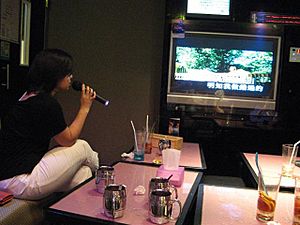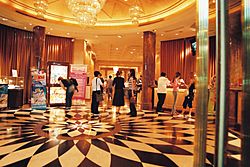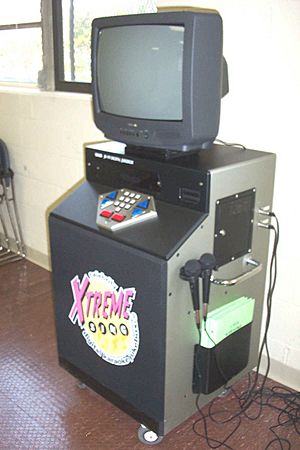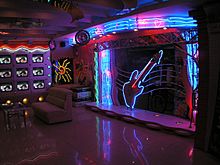Karaoke facts for kids

Karaoke is a fun way to sing along to recorded music using a microphone. It's usually found in clubs and bars, but also in special private rooms. The music is an instrumental version of a well-known song, meaning it has all the instruments but no main singer. The words, called lyrics, are shown on a screen. They often change color or have a moving symbol to help you know when to sing. In places like China, Hong Kong, Taiwan, and Singapore, a karaoke place is often called a KTV. People all over the world enjoy karaoke, and it's a huge business!
Contents
How Karaoke Started

Singing along to music has been around forever, but new technology made it much easier.
Early Ideas (1960s)
In the 1960s, TV shows like Sing Along with Mitch in America showed song lyrics on the screen. This was similar to karaoke, but it still had a main singer. The big change came when music became easier to carry around. Cassette tapes, which were small and easy to copy, helped musicians take their music with them. This made it possible for people to sing along without a live band.
The First Machines (1970s)
The idea of a karaoke machine came from different people in Japan. Even before the machines, the word "karaoke" was used when a singer used recorded music instead of a live band.
In 1967, a Japanese engineer named Shigeichi Negishi made the first machine. He called it the "Sparko Box." It used 8-track tapes with instrumental music, and the words were in a paper book. But he stopped making them because of problems selling them.
Another person, Toshiharu Yamashita, sold a machine in 1970 that played 8-track tapes for singing along.
Then, in 1971, a musician named Daisuke Inoue from Kobe, Japan, created his own karaoke machine. He realized that regular people found it hard to sing pop songs. So, he recorded popular songs in easier keys (pitches) and added an echo effect to help singers sound better. He didn't patent his invention, but he helped create the modern karaoke business.
Inoue's machine, called the "8 Juke," was a coin-operated player using 8-track tapes. He loaned these machines to bars for free and shared the money they made. At first, they weren't popular, but then he hired people to sing on them, which made others interested. Karaoke quickly spread from Kobe across Japan. In the 1980s, private karaoke rooms, called karaoke boxes, became very popular.
In 1975, Roberto del Rosario from the Philippines developed his own sing-along system and is recognized as having a patent for a karaoke system.
Newer Ways to Play (Later Years)
After the LaserDisc came out in the 1980s, companies like Pioneer started making video karaoke machines. These could show lyrics on a video that played with the music.
In 1992, a scientist named Yuichi Yasutomo created a system that sent songs in a special format (MIDI) over phone lines to karaoke machines. This was like an early form of music streaming! It became very popular in Japan.
Karaoke then spread to other parts of Asia and around the world. Home karaoke machines also appeared, but they weren't as popular in America. So, companies started selling them as part of home theater systems, with karaoke as an extra feature.
Today, many bars have karaoke nights with great sound systems and big screens.
How Karaoke Works
A basic karaoke machine has a music player, places to plug in microphones, a way to change the song's pitch (how high or low it sounds), and speakers. Some machines try to remove the original singer's voice from regular songs, but this often doesn't work perfectly. Most common machines use special discs like CD+G, LaserDisc, VCD, or DVD, which show lyrics and pictures on a screen.
Many karaoke machines can change the song's pitch without changing its speed. This helps singers choose a key that fits their voice.
A fun game is "Kamikaze Karaoke" or "Karaoke Roulette." You pick a random song number and try to sing whatever comes up!
Some home systems try to remove vocals by using a trick called "center channel extraction." This works because the main voice is usually in the middle of a stereo recording. But it can also remove other instruments, making the music sound strange. Newer methods using computers work much better.
From Tapes to Digital
Early karaoke machines used 8-track tapes or cassette tapes with printed lyric sheets. But soon, CDs, VCDs, LaserDiscs, and DVDs took over. In the 1980s and 1990s, Pioneer made many high-quality karaoke music videos.
In 1992, a company called Taito introduced a machine that got music through phone lines. This allowed for new songs to be added easily. Today, many karaoke machines use fiber-optic cables for instant, high-quality music and video.
Modern karaoke systems often use hard drives to store thousands of songs. They also have touch screens for easy song selection. Some newer systems even stream songs from the internet, meaning you don't need to store them on the machine itself.
Karaoke Video Games

The first karaoke video game, Karaoke Studio, came out for the Nintendo Famicom in 1985. But it didn't have many songs.
In 2003, Karaoke Revolution came out for the PlayStation 2. Players sang along with on-screen guides and got a score based on how well they matched the pitch and rhythm. This game led to many sequels. Another popular series is SingStar, especially in Europe. Other games like Guitar Hero and Rock Band also let players sing.
Karaoke on Your Phone
Since 2003, you can find karaoke services on mobile phones. These apps often use special files that combine music and lyrics. Many apps are available for Android, iPhone, and other devices.
Karaoke in Cars
Some cars even have karaoke machines! In the 1990s, taxis in South Korea had them. In 2003, a Chinese car company, Geely, put a karaoke machine in their Beauty Leopard car. Some newer Tesla cars also have a "Car-a-oke" app.
Other Ways to Play Karaoke
Special karaoke discs like CD+G have lyrics hidden in a special part of the disc. You need a special player (or some video game consoles) to see them. There's also software for computers that can play karaoke songs.
Many microphone-based karaoke players are popular for home use. You just plug them into a TV. They often have features like pitch correction and sound effects.
Silent Karaoke
"Silent karaoke" is a special microphone that lets you practice singing without making much noise.
Karaoke Words to Know
- Jūhachiban: (pronounced "joo-hah-chee-bahn") This is a Japanese word for a song that someone sings especially well and uses to show off their singing skills.
- Karamovie or Movioke: This is like karaoke, but you sing along to scenes from movies instead of just music. You act out your favorite movie parts!
- Karaoke jockey (KJ): This person plays and manages the music at a karaoke event. They announce songs and tell people when it's their turn to sing.
- Hitokara: (pronounced "hee-toh-kah-rah") This is a Japanese word for singing karaoke alone. It's become very popular in Japan, India, and China for people who want to practice or just enjoy singing by themselves.
Karaoke Around the World

Asia
In Asia, the most popular place for karaoke is a karaoke box. This is a small, private room with karaoke equipment that you rent by the hour. These places often have food and drinks too. In South Korea, they're called norebangs, and in mainland China and Taiwan, they're called KTVs.
Singing is a big part of social life in Korea. Noraebangs are very common and are often used by families. Some people even go to noraebangs by themselves to relieve stress.
In the Philippines, karaoke (often called videoke) is a favorite home activity. People love to sing along to "minus-one" instrumental tracks.
After the COVID-19 pandemic, karaoke bars in Japan reopened with rules like wearing masks and using microphone covers to keep everyone safe.
North America and Europe
In North America and Europe, you'll often find karaoke in bars, restaurants, or clubs. These places usually let you sing for free, hoping you'll buy food and drinks. Some places have karaoke every night! Private karaoke rooms, like those in Asia, are also becoming more common in big cities like Toronto and New York City.
Sometimes, you can even sing with a live band instead of a recorded track! This is called "live band karaoke."
Australia
Karaoke became popular in Australia in the late 1980s, brought by Filipino immigrants who had their own "minus-one" music tapes. At first, people used video tapes with lyrics on TV screens. Later, special plug-and-play microphones with hundreds of built-in songs became popular for home use.
In 1989, Robin Hemmings introduced commercial karaoke to Australia using LaserDisc systems. Karaoke became very popular in Adelaide, with many hotels offering karaoke nights. While its popularity went down for a while, karaoke bars are now popular again, especially among students.
Making Karaoke Music
In Asian countries, many artists release a karaoke version of their songs at the same time as the original. These often come in a special MIDI format with lyrics on a video background. In Europe and North America, karaoke tracks are usually re-recorded by other musicians, not the original artists.
Karaoke Contests
Karaoke contests are very popular around the world. They give non-professional singers a chance to show off their talent and win prizes. The Karaoke World Championships is one of the biggest contests, held every year since 2003.
World Records
- In 2009, over 160,000 people sang "Friends in Low Places" by Garth Brooks at a race in the United States, setting a record for the most people singing karaoke.
- Hungary holds the record for the longest karaoke marathon with many singers, lasting over 1,011 hours in 2011!
- The record for the longest solo karaoke marathon belongs to Leonardo Polverelli from Italy, who sang 1,295 songs for over 101 hours!
Images for kids
-
A row of 3 karaoke booths at a shopping center in Angeles City, Philippines.
-
A karaoke bar in Oulu, Finland.
See also
 In Spanish: Karaoke para niños
In Spanish: Karaoke para niños
- Closed captioning
- Fansub
- List of English words of Japanese origin
- Music Minus One
- PowerPoint karaoke
- Same language subtitling
- Subtitling
- Surtitles
- Utagoe Kissa









